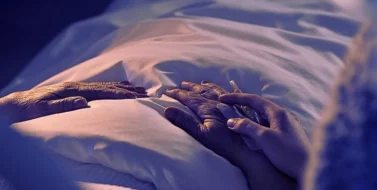Inadequate nurse staffing in Illinois assisted-living facilities puts residents at risk for worsened health conditions, serious injuries, or death. There are more than 15,000 nursing homes in operation across the U.S. Families often make the difficult decision to move loved ones into these assisted-living facilities to ensure they get the help and care they need to thrive. Lacking adequate staff, however, many facilities fall short of providing the assistance they promise to patients and their families.

Table of Contents
The Problem of Inadequate Staffing in Nursing Homes
Inadequate staffing has been an ongoing problem for nursing homes throughout the U.S. The American Health Care Association reported that as of June 2022, 87% of nursing homes were experiencing moderate or high staff shortages. Without enough staff to care for their residents, even the best-intentioned nursing homes may fall short of providing the care that residents need and deserve.
Nursing home shortages exist, despite federal staffing rules in place to help ensure resident safety. The Centers for Medicare and Medicaid Services requires assisted-living facilities to have at least one registered nurse on duty for eight hours every day. However, a USA Today report found that more than three-quarters of the nation’s nursing homes failed to staff nurses or aides as directed by the Medicare payment formula in 2021.
Why Are Nursing Homes Understaffed?
Numerous factors contribute to the continued issue of understaffed nursing homes in Illinois and across the U.S., including wages and benefits, the working environment, and the workload. Additional factors include difficulty drawing in and retaining workers in the field.
Many of the factors that contribute to nursing home under-staffing existed prior to the COVID-19 public health emergency. However, the pandemic shined new light on, and exacerbated, several of these long-standing challenges. As the nursing home care sector has been one of the slowest sectors to recover workers who left during the pandemic, these issues have continued to affect these facilities, and the care they provide to their residents.
Wages and Benefits
The wages that nurses and caregivers in assisted-living facilities earn do not adequately reflect the importance of the services they provide. One news report puts the median hourly wage for workers in nursing homes as $15.22, well below the average median hourly wage in the U.S. Although in the healthcare field, nursing homes also often do not offer workers employer-provided health insurance and retirement benefits. A lack of competitive, or for some, even adequate, pay and compensation packages has led many would-be nursing home employees to seek work in other types of facilities or fields.
Working Environment
Employees in all healthcare settings can face dangerous conditions in their working environments, leading some to look for work elsewhere. From potential exposure to contagious illnesses to assault by combative patients or families, nursing home staff may have an increased risk of suffering occupational injuries or illnesses. The added risk they may face in this particular job setting moves some to leave or to never pursue a career working as a caregiver in a nursing home.
Workload
The stress on the workforce, combined with the ever-increasing portion of the population needing care, has also contributed to inadequate nurse staffing in assisted-living facilities. Nurses, aides, and other caregivers are often asked to perform their roles in addition to the roles of other staff the facility lacks. Additionally, they may have to care for more residents at one time than is safe or effective. For many, the increased workloads add to burnout, which may cause them to pursue jobs outside the nursing home sector.
Recruitment Problems
Assisted-living facilities struggle to recruit employees, making it difficult to provide adequate staff. Traditionally, nursing homes have attracted those in the workforce who want to help others. Due to factors such as reports of neglect and abuse, the public image of employees in this field is not what it once was. Feeling a lack of respect for the work they perform, in addition to uncompetitive wages and working condition shortcomings, fewer and fewer who see themselves as caregivers are seeking employment in nursing homes.
Poor Staff Retention
Nurse turnover is also a problem for assisted-living facilities. Federal statistics suggest that at least half of nursing staff turns over within a year. The same factors that make it difficult for nursing homes to draw in hires are the same that push workers out of the field. Rather than continue to deal with issues such as unsafe working conditions and poor wages, many have sought similar work, or other positions entirely, outside the nursing home setting.
Consequences of Inadequate Staffing in Nursing Homes
When nursing homes fall short of safe staff-to-patient ratios, it can have dire consequences for residents. It may also result in administrative action against the facilities.
If during a routine inspection or when investigating a complaint, the Illinois Department of Public Health identifies staffing deficiencies, it may take corrective actions. The department will give the facility the opportunity to rebut the finding, as well as to detail a plan for corrective action.
Depending on the circumstances, and whether the facility rectifies the violation, the department may appoint temporary managers, limit admissions, levy fines, or take other such actions. In some cases, the IDPH may suspend or revoke the licensure that allows these facilities to operate. Consequently, a nursing home may close after widespread patient neglect.
The aforementioned consequences may cause operational challenges for facilities. However, the most serious repercussions of under-staffing in nursing homes impact the residents of these facilities. Nurse staffing and patient care quality and safety are directly linked. Therefore, under-staffing and nursing home neglect and abuse often go hand-in-hand.
Without enough caregivers, residents may not get the help they need with personal hygiene tasks, miss medications or other important steps in their care plans, or otherwise not receive the standards of care they deserve. Overstretched staff may take frustrations out on patients, causing physical or emotional harm, or both.
Types of Elder Abuse and Neglect
As a result of under-staffing and other factors, the residents of nursing homes may suffer varying types of abuse and neglect at the hands of care staff. Some types of abuse and neglect that may occur in assisted-living facilities include:
Physical Abuse
Physical abuse occurs when a staff member uses physical force that causes impairment, physical pain, or bodily injury to a resident. For example, this includes pushing or shoving, hitting or slapping, shaking, pinching, or burning.
The inappropriate use of physical restraints or medications also qualifies as physical abuse of nursing home residents. Sometimes, employees take these measures in reaction to not having adequate staff to patient ratios. In such cases, they may think they are doing what is best for their patients, not actually causing them potentially serious harm.
Sexual Abuse
Non-consensual sexual contact of any kind is considered sexual abuse of an elderly adult. For example, this includes coerced nudity, unwanted touching, or sexual assault or battery. Sexual contact with a nursing home resident that cannot give consent also constitutes this type of elder abuse.
Emotional or Psychological Abuse
Emotional or psychological abuse of nursing home residents involves using verbal or nonverbal acts to cause distress, anguish, or pain. Acts that may fall under the umbrella of emotional or psychological abuse include insulting, threatening, intimidating, humiliating, harassing, or verbally assaulting elders.
Neglect
Sometimes, it is not the actions that nursing home staff take that harm residents; rather, it is the things they do not do. Failing to carry out their duties to residents as caregivers, neglect includes not providing patients with adequate shelter, food, water, clothing, and other necessities. Neglect also involves failing to ensure residents have access to medical care, receive care based on their treatment plans, or otherwise get the essentials they and their families were promised.
Signs of Elder Abuse and Neglect
Nursing home residents who suffer abuse and neglect may experience ranging physical and emotional effects. Some signs that an assisted-living patient is suffering abuse or neglect are easily identifiable. Others, however, can be difficult to attribute to this type of mistreatment by those charged with nursing home residents’ care.
Abuse or neglect can affect any patients living in nursing care facilities. Unfortunately, however, many of those who suffer such mistreatment at the hands of those charged with their care cannot or will not report abuse or neglect. Knowing the physical and emotional signs to look out for may help people protect their loved ones.
Physical Signs
Physical signs of abuse and neglect are among the most identifiable, as they are often easily spotted. Here are 6 warning signs of elder abuse:
- Lacerations, cuts, punctures, or open wounds
- Black eyes, bruises, sprains, or dislocations
- Broken bones
- Skull fractures
- Poor hygiene
- Unexplained malnourishment or dehydration
Additionally, lab reports indicating that an older adult is getting too much or too little of prescribed medications may also be a sign that he or she is suffering abuse or neglect.
Emotional Signs
Emotional signs of abuse and neglect are often more challenging to identify. These types of indicators that a nursing home resident may be experiencing abuse or neglect include suddenly seeming confused or withdrawn, new and unexplained anxiety or depression, and isolation from family and friends.
Reporting Nursing Home Abuse and Neglect
Whether due to under-staffing or not, there are several options for reporting nursing home abuse and neglect in Illinois. Elder abuse reports in Illinois can be made to the regional ombudsman, the IDPH, the healthcare and family services hotline, or law enforcement. Knowing where to file a complaint and the elder abuse statute of limitations may help families protect their vulnerable loved ones.
Long-term care ombudsmen are not emergency responders; however, they will investigate complaints of elder mistreatment in nursing homes. If the ombudsman’s investigation verifies the complaint, measures will be taken to achieve a resolution, In cases involving criminal acts or professional misconduct, the ombudsman will make a formal report with the appropriate state agency. The Illinois Department of Public Health and the Healthcare and family services hotline conduct similar investigations and take similar actions when they receive reports.
If nursing home residents have suffered harm that requires immediate medical care, or family members fear they are at serious risk, they should call 911.
Combating Under-Staffing in Illinois Nursing Homes
At least in part because of the link between nurse-to-patient ratios and patient outcomes, Illinois recently entered into law new staffing requirements for nursing homes. These requirements aim to help improve the care patients receive in these facilities and the conditions for workers. Under the law, which requires full compliance by 2025, nursing homes must staff based on the care needs of their residents.
Facilities must provide adequate employees to give each resident requiring intermediate care at least 2.5 hours of care per day, and each resident requiring skilled care a minimum of 3.8 hours of care per day. Of this care, 10% must be provided by registered nurses and 25% must come from licensed practical nurses.
In addition to dictating the percentage of care that must come from nurses, Illinois state laws also specify how this required care should be distributed over the course of a full day. Facilities must staff to provide 40% of the care time patients require during the day, 25% in the evenings, and 15% overnight.The intent is that these minimum requirements will help ensure that patients in nursing homes receive the care they need. Should inadequate nurse staffing occur, despite state and federal laws, injured residents or their families may consider actions, such as consulting with a nursing home abuse and neglect lawyer, making a formal report, and filing a nursing home neglect lawsuit.





